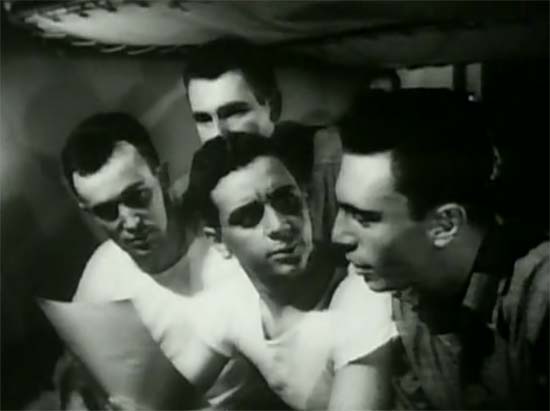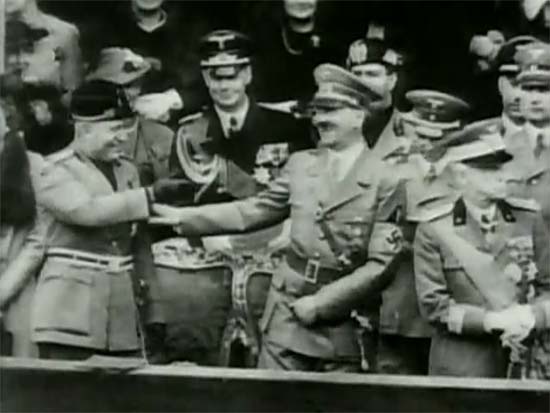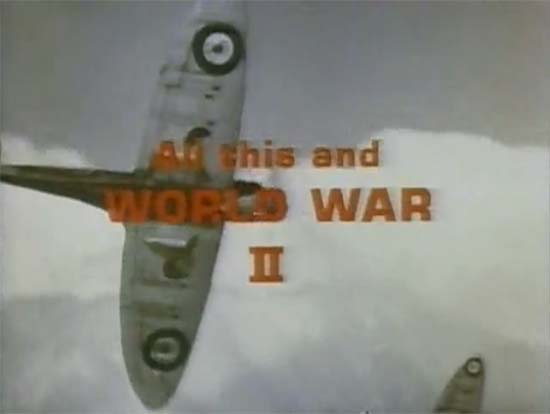 As a Beatles fan, I had heard about this film for many years, but was under the false impression that it never actually got made. It’s mentioned as seldom as May Pang. But recently, while I was in the basement of a local record store scavenging through vinyl soundtracks, I encountered a thick box for the double LP All This and World War II. I was astonished. The 1976 release contained twenty-eight Beatles covers from such artists as Peter Gabriel, Tina Turner, the Bee Gees, Keith Moon of The Who, Jeff Lynne of Electric Light Orchestra, Elton John, Roy Wood of The Move, David Essex, The Four Seasons, Helen Reddy, Frankie Valli, and even The Status Quo. My sense of pop culture reality seriously damaged, I returned home and tracked down the film online. Yes, the film exists. It’s never been released on video, and has had only a few scattered theatrical and television screenings following its brief original run; in the age of the internet, as long as there are like-minded folks, you can find most rarities without too much difficulty. But I can tell you now that when that fateful day occurs and Let it Be is finally released on Blu-Ray so everyone except for Paul McCartney can enjoy it, All This and World War II will remain in the vaults, right alongside the unreleased The Long and Winding Road documentary and other Beatles never-will-be’s. Why? Because the film is so ill-advised and instantly irrelevant that it somehow vanishes into the ether just after you’ve watched it.
As a Beatles fan, I had heard about this film for many years, but was under the false impression that it never actually got made. It’s mentioned as seldom as May Pang. But recently, while I was in the basement of a local record store scavenging through vinyl soundtracks, I encountered a thick box for the double LP All This and World War II. I was astonished. The 1976 release contained twenty-eight Beatles covers from such artists as Peter Gabriel, Tina Turner, the Bee Gees, Keith Moon of The Who, Jeff Lynne of Electric Light Orchestra, Elton John, Roy Wood of The Move, David Essex, The Four Seasons, Helen Reddy, Frankie Valli, and even The Status Quo. My sense of pop culture reality seriously damaged, I returned home and tracked down the film online. Yes, the film exists. It’s never been released on video, and has had only a few scattered theatrical and television screenings following its brief original run; in the age of the internet, as long as there are like-minded folks, you can find most rarities without too much difficulty. But I can tell you now that when that fateful day occurs and Let it Be is finally released on Blu-Ray so everyone except for Paul McCartney can enjoy it, All This and World War II will remain in the vaults, right alongside the unreleased The Long and Winding Road documentary and other Beatles never-will-be’s. Why? Because the film is so ill-advised and instantly irrelevant that it somehow vanishes into the ether just after you’ve watched it.
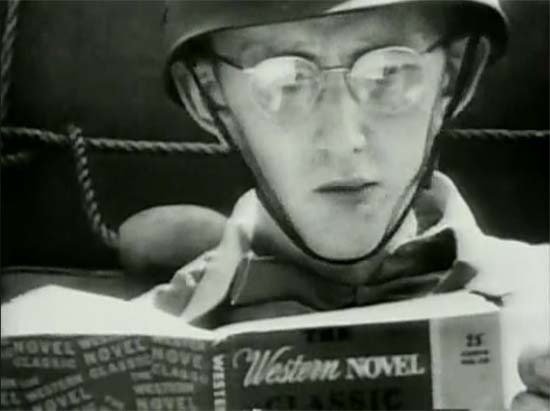 Imagine, if you will, stock footage of World War II. Most of it in black and white, some of it in color. Imagine footage from old Hollywood and British war movies. Imagine that all of this is edited together into a clip show which runs almost an hour and a half, with no narration, and dominated by a soundtrack of Beatles covers. Congratulations, you have imagined this entire film. Would you like a job at Twentieth Century Fox?
Imagine, if you will, stock footage of World War II. Most of it in black and white, some of it in color. Imagine footage from old Hollywood and British war movies. Imagine that all of this is edited together into a clip show which runs almost an hour and a half, with no narration, and dominated by a soundtrack of Beatles covers. Congratulations, you have imagined this entire film. Would you like a job at Twentieth Century Fox?
I don’t know that “documentary” is the world to describe this. It certainly documents World War II, in that the footage relates to the subject. One could say that it presents an image of the war as it was experienced by those who lived through it, and simultaneously as it was interpreted into propaganda through Hollywood, but even that modest statement seems to grant the film a goal more defined that it seems to have intended. Watching this film, you really won’t learn that much that you didn’t already know about the war (unless you failed to ever take a high school history class). The goal does not seem to be to educate. And yet, despite the almost nonstop presence of Beatles covers, it does not succeed as a “head” film, either. It’s not very psychedelic, beyond Lennon & McCartney’s occasionally psych lyrics. They don’t ever tint the film or warp the images. There are no Godard-style intertitles punning or making political comment. It is not even edited in a fashion that is remarkable, or very worthy of critical attention.
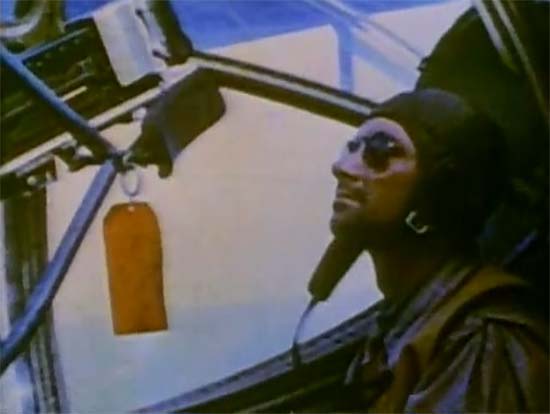 The thinking, so far as I understand it, is that someone had a large collection of WWII footage and thought it might make a good compilation film. The thinking then advanced, apparently without any words of advice, that said WWII footage would be enhanced by the music of the Beatles. Because who doesn’t love the Beatles? Hitler, that’s who. Yeah, that’s it…we’ll play “The Fool on the Hill” over footage of Hitler in the countryside. We’ll play “Michelle” over footage of troops in France. We’ll play “I Am the Walrus” to accompany the Japanese attack on Pearl Harbor for some reason.
The thinking, so far as I understand it, is that someone had a large collection of WWII footage and thought it might make a good compilation film. The thinking then advanced, apparently without any words of advice, that said WWII footage would be enhanced by the music of the Beatles. Because who doesn’t love the Beatles? Hitler, that’s who. Yeah, that’s it…we’ll play “The Fool on the Hill” over footage of Hitler in the countryside. We’ll play “Michelle” over footage of troops in France. We’ll play “I Am the Walrus” to accompany the Japanese attack on Pearl Harbor for some reason.
The film’s primary expense, then, would be getting the rights to Beatles music. But wait…what if it were only Beatles covers? That could be cheaper. Then a soundtrack could be compiled, and there would be a hit record to accompany the hit film. Why would the film be a hit? Because obviously everyone loves to watch WWII stock footage while listening to Beatles music. And they love to spend their dollars to have that experience in a theater.
The producers seem to be under the impression that Beatles music can cure all ills, including an excruciatingly poor notion of a film. An understandably giddy enthusiasm for the Fab Four’s catalog leads them down a very strange road indeed. One wonders exactly what sort of resonance is intended by marrying this music to these images. Little is achieved. Those songs which seem to have something to do with the footage (“She’s Leaving Home” over footage of women joining the war effort, for example) do little but state the obvious. The more unusual choices (“I Am the Walrus”) are more sporadically successful at achieving a modicum of interest, or a rare moment of cinematic frisson. None of this justifies a movie.
I keep trying to picture the ideal audience for All This and World War II. Since the juxtaposition of Beatles music and WWII imagery does nothing for me, perhaps it would for someone who grew up during the 1940’s and listened to the Beatles in the 60’s. I don’t doubt that screening footage of Winston Churchill, or Eleanor Roosevelt, or dogfights with the Luftwaffe, or storming the beach of Normandy would trigger something more in one who lived through that era, than somebody like me, who knows it as history. Show this to one of the Greatest Generation, and he might feel these images in his gut…as a younger person might with images of 9/11, or Donald Rumsfeld, or George W. standing before a “Mission Accomplished” sign. Then again, our culture is one that replays its iconographic images on a loop; we self-obsess, and air documentaries and television specials, and print commemorative issues of Newsweek and Time and sell commemorative coins and plates, and proclaim the cultural and historic importance of this and that in neatly organized top ten lists for every decade. Raising the flag at Iwo Jima was a stirring image once, but it has become as familiar as the picture printed on a dollar bill. Fitting, then, that All This and World War II features a scene from a Hollywood movie portraying that moment at Iwo Jima. Presented now as just another moment in this musical clip show, we’re even further divorced from the ability to feel anything at all about victory in this battle or in the war as a whole. I hope that the editor felt something, at least. This movie must be for someone.
What most hurts the film’s chances of enduring the tides of time is that in this day and age, anyone can make a compilation film. Basic video editing programs come standard with most computers. The internet is crammed with amateur works using found footage to stronger effect than what is achieved in All This and World War II. We now think in the language of video editors. It’s become as second-nature as typing on a keyboard or texting with a cell phone. In 1976, before the home video market, musical-clip-show That’s Entertainment had already been a hit and That’s Entertainment, Part II was rushed into theaters, so audiences could relive great moments from great movies. Presumably All This and World War II was meant to do for Twentieth Century Fox what those earlier films had done for MGM. It failed. This might not have happened if it had been a straightforward documentary on WWII, or, alternately, a musical featuring Beatles music. (One that doesn’t star Peter Frampton and the Bee Gees.) Decades later, Julie Taymor’s Across the Universe became a modest art house hit on the strength of using Beatles covers woven into a musical narrative. Her film is exponentially more successful. Then again, she actually made an effort.
Curiosity seekers will still pursue All This and World War II. Do so. Climb that mountain, plant your flag, declare “this film exists after all!”
Or it did, anyway. But, unlike the Beatles’ songs, this film is of history and constrained to it. Soon enough you’ll forget you planted your flag, or climbed that mountain, or once wasted an hour and a half of your life. I’ll say this for the film: it has no sour aftertaste, or any lasting flavor at all.
